|
 Hysterangium neotunicatum Hysterangium neotunicatum
SynonymsHysterangium tunicatum
Hysterangium sp. 5
BiostatusPresent in region - Indigenous. Non endemic
Images (click to enlarge)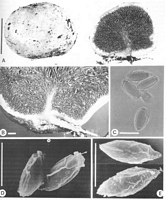
Caption: Fig. 5 Hysterangium neotunicatum. A, Basidioma exterior and in section (PDD 51927). B,
Detail of basidioma attachment region in section (PDD 51927). C, Basidiospores by bright
field (PDD 55923). D, Basidiospores by SENT (PDD 8321, type of H | 
Caption: scale=1mm
Owner: J.A. Cooper | 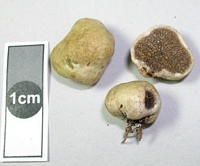
Caption: note thick rhizoids
Owner: J.A. Cooper | 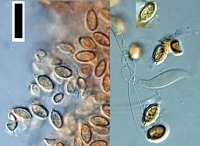
Caption: scale=20um
Owner: J.A. Cooper | 
Caption: Portion of surrounding soil/root mass and rhizomorphs.
Owner: Herb PDD | 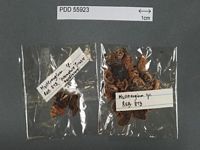
Caption: Dried type specimen
Owner: Herb PDD | 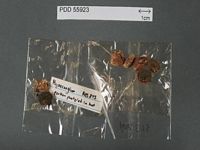
Caption: Dried type specimen
Owner: Herb PDD | 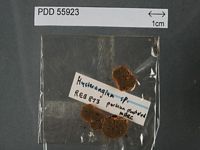
Caption: Dried type specimen
Owner: Herb PDD | 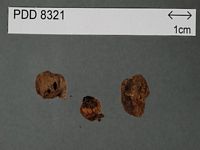
Caption: Dried type specimen
Owner: Herb PDD |
Article: Castellano, M.A.; Beever, R.E. (1994). Truffle-like Basidiomycotina of New Zealand: Gallacea, Hysterangium, Phallobata, and Protubera. New Zealand Journal of Botany 32(3): 305-328 (http://www.rsnz.org/publish/abstracts.php).
Description: Basidiomata up to 2.5 cm diam., globose to subglobose, irregular or reniform, when
fresh dull white to yellowish brown or greenish grey and sometimes cracked where
exposed, bruising pale reddish brown to reddish brown or grey, surface somewhat
glabrous; EtOH pale pink to red. Gleba olive to dark greyish olive; locules elongate,
empty or partially filled, deliquescing. Rhizomorph single, stout, up to 1 mm diam.,
soon branched, attached to slightly indented base, concolorous with peridium. Columella
dendroid, gelatinous, opaque to translucent, arising from a sterile base. Taste slightly
peppery. Odour musty sweet to slightly acetylenic, becoming sweet-smelling on
deliquescing. Peridium easily separable from gleba, 600-900 µm thick, 2-layered;
epicutis 500-700 µm thick, of hyaline, thin-walled, irregularly inflated cells
(parenchyma-like), 20-65 µm diam., smaller near outer surface, clamp connections
absent; subcutis 100-200 µm thick, of hyaline, thin-walled, interwoven hyphae, 3-8 µm
diam., clamp connections absent. Trama 50-70(-200) µm thick, of hyaline, compactly
interwoven hyphae, 2-3 µm diam., in a gelatinised matrix, clamp connections absent.
Basidia rehydrating poorly, hyaline, 6-spored. Spores smooth, 11-14 x (4-)5-6.5 µm,
fusiform to broadly fusiform, apex acuminate, base with a short sterigmal attachment;
wall <0.5 µm thick. Utricle distinct, laterally inflated up to 2 µm, irregularly loose or
baggy. Spore colour in KOH pale green singly, green in mass.
Habitat: Habitat: hypogeous to subepigeous in scrubland and modified forest, putatively
mycorrhizal with Leptospermum ericoides and L. scoparium. Season: throughout the year.
Distribution: Argentina, Australia, New Zealand.
Notes: ETYMOLOGY: From Greek neos, new, and tunicatum, in reference to the invalidly
published earlier name, which presumably referred to the tunic-like inflated utricle.
REMARKS: Hysterangium tunicatum Cunningham was published after 1935 without a
Latin diagnosis, so is a nomen nudum in accordance with the Botanical Code, Article
36.1. The epithet neotunicatum is proposed to accommodate this species, which has
spores similar to those of H. inflatum but with an irregularly inflated utricle; the two
species differ vastly in peridial characters. Chu-Chou & Grace (1983) illustrate this
species as "Hysterangium sp 5", although as their fig. 15 rather than fig. 14.
Hysterangium neotunicatum differs from H. rugisporum, which also occurs under
Leptospermum, by its smooth spores, 2-layered peridium, and pink to red reaction with
EtOH and bruising. The spores of H. neotunicatum are smaller than those of H. youngii.
Two collections [AUCKLAND, Waitakere Ranges, Huia Dam Track, R.E. Beever 761,
18 Jun 1988 (PDD 48321, OSC); ?locality, M. Chu-Chou, 25 May 1982 (NZFRI 3299)]
placed in H. neotunicatum on the basis of peridial characters approach H. rugisporum in
spore ornamentation.
Article: Gadgil, P.D. (in association with Dick, M.A.; Hood, I.A.; Pennycook, S.R.) (2005). Fungi on trees and shrubs in New Zealand. Fungi of New Zealand. Ngā Harore o Aotearoa 4: xi + 437 p. Hong Kong: Fungal Diversity Press.
Description: Type: Mycorrhizal Fungi; Description: Basidiomata hypogeous to subepigeous, globose to subglobose, dull white to yellowish brown, pale reddish brown when bruised, up to 25 mm in diameter, with a single, stout rhizomorph; peridium in two layers, white in section. Gleba olive to dark greyish olive; locules elongate, empty or partially filled with basidiospores, deliquescing; tramal plates of interwoven, hyaline hyphae; columella branched. Basidiospores fusiform, 0-septate, 11–14 × 5–7 μm, smooth, pale green; utricle distinct, irregularly loose, inflated laterally up to 2 μm.
Distribution: Distribution: Northland, Auckland, Coromandel, Waikato, Bay of Plenty, Taupo, Wellington, Nelson, Mid Canterbury, Dunedin.; 1st Record: Chu-Chou & Grace (1983b: as Hysterangium sp. 5).
Article: Cunningham, G.H. (1938). The Gasteromycetes of Australasia, XVIII. Transactions and Proceedings of the Royal Society of New Zealand 67(4): 408-410 Wellington:.
Description: Plants subglobose, to 2 cm. diameter, attached by a prominent basal strand, yellowish-brown
to ferruginous, somewhat wrinkled when dry. Peridium 350-611 microns thick,
readily separable in mature plants, of a single layer of compact pseudoparenchyma. Gleba
ollivaceous, cells elongate, 2-6 mm. long, arranged radially, partially filled with spores;
columella dendroid, arising from a sterile base; tramal plates 80-200 microns thick,
composed of densely compacted gelatinized hyphae; basidia 6-spored. Spores fusiform,
11-14 x 5-6-5 microns, tinted yellow, apex acute, base pedicellate, covered with a
conspicuous inflated exospore which is more prominent basally.
|